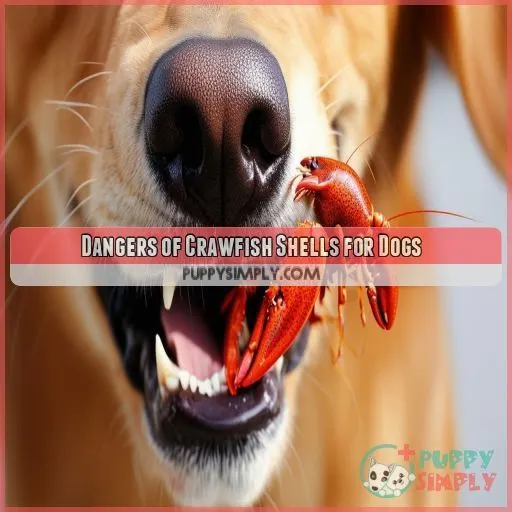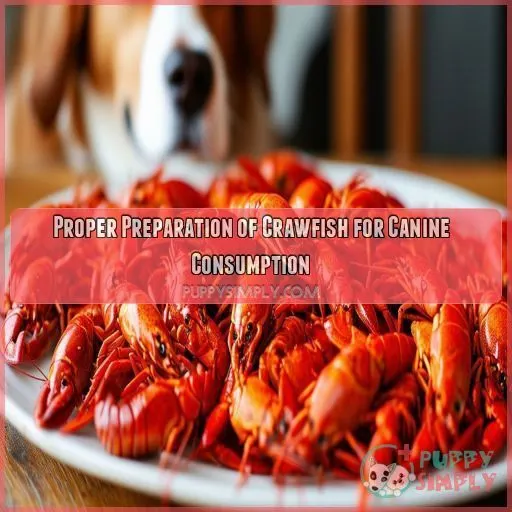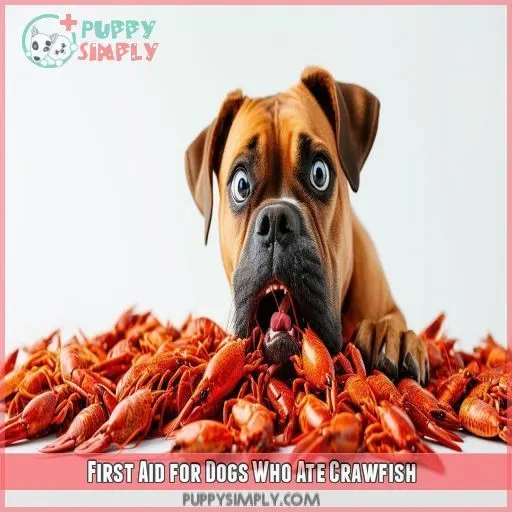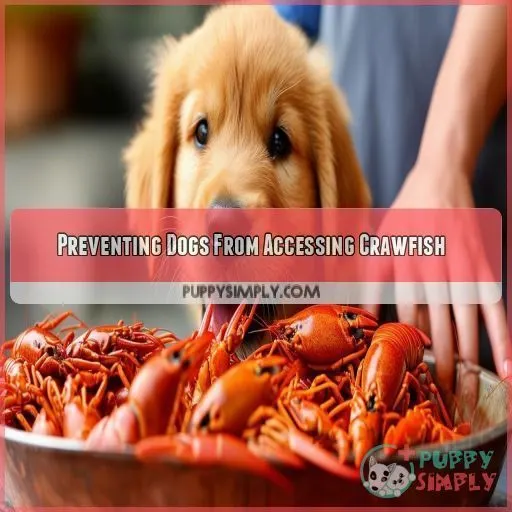This site is supported by our readers. We may earn a commission, at no cost to you, if you purchase through links.
 Yes, dogs can eat crawfish, but only in moderation.
Yes, dogs can eat crawfish, but only in moderation.
Crawfish is a high-fat, high-cholesterol food, so too much can cause digestive problems and liver damage.
Make sure the crawfish is cooked, unseasoned, and shell-free before you share it with your dog.
Some dogs are allergic to shellfish, so watch out for scratching and itching.
Want to know more?
Table Of Contents
Key Takeaways
- Crawfish are high in fat and cholesterol, so they should only be given to dogs in moderation and as a rare treat.
- It is important to remove the shells from crawfish before feeding them to dogs, as the shells can cause choking, intestinal irritation, and blockages.
- Crawfish provide some nutritional benefits for dogs, including protein, omega-3 fatty acids, and vitamins and minerals, but these benefits are relatively minor in the context of a dog’s overall diet.
- There are several alternatives to crawfish that are safer and healthier for dogs, including fish, sardines, oysters, scallops, chicken, turkey, fruits, vegetables, and commercial dog treats.
Can Dogs Safely Consume Crawfish?
You’ve probably wondered if it’s safe to share your crawfish feast with your furry friend. While dogs can eat small amounts of plain, cooked crawfish meat, there are some important risks and precautions you need to know about before tossing Fido a tasty crustacean morsel.
Nutritional Value of Crawfish for Dogs
Ever wondered if your pup can join in on your crawfish feast?
Well, you’re in for a surprise! Crawfish pack a protein punch that’ll make your dog’s tail wag.
They’re like little underwater powerhouses, loaded with lean meat that’s easy on the doggy digestive system.
But hold your horses – it’s not all smooth sailing in the crawfish world for our furry friends.
Let’s sniff out the facts!
Potential Health Benefits for Canines
While crawfish aren’t necessarily toxic to dogs, there are some health benefits to be aware of. Crawfish are a good source of protein and omega-3 fatty acids, which can promote healthy skin and a shiny coat. They also contain vitamins and minerals like B12, selenium, and phosphorus, which support overall health and well-being.
However, it’s important to remember that these benefits are relatively minor in the grand scheme of your dog’s diet, and there are plenty of other foods that can provide the same nutrients without the potential risks associated with crawfish.
Risks Associated With Feeding Crawfish to Dogs
While crawfish are a tasty treat for your dog, there are some risks to keep in mind. The shell is the biggest concern, as it can cause choking or get stuck in your dog’s digestive system. Crawfish shells can also carry pathogens, leading to intestinal blockage and discomfort.
Another risk is salt toxicity. The extra salt in human food, including crawfish, can cause digestive and neurological issues like vomiting, diarrhea, and seizures. Always be cautious of the amount of salt your dog consumes.
Recommended Serving Sizes for Different Dog Breeds
Now, let’s talk about serving sizes. How much crawfish can your dog safely eat? Well, it depends on their size and breed.
For small breeds, like Chihuahuas or Toy Poodles, a couple of crawfish tails are enough. Medium breeds, such as Beagles or Spaniels, can have a few more. As for large breeds, think Labradors or Golden Retrievers, they can handle a larger portion, but don’t go overboard.
Dangers of Crawfish Shells for Dogs
Now, let’s get down to the nitty-gritty. What happens if your furry friend gobbles up some crawfish shells? Well, it’s not pretty, but we’re here to shell it out for you.
The main concern with crawfish shells is the potential for blockage in your dog’s digestive tract. Those shells are tough little suckers and can cause some serious irritation and even bowel obstruction. Imagine your dog’s intestines as a busy highway, and those shells as a roadblock—not good!
Another thing to watch out for is intestinal irritation. Crawfish shells aren’t exactly smooth sailing for your dog’s insides. They can cause inflammation and discomfort, leading to loose stools or even vomiting.
Proper Preparation of Crawfish for Canine Consumption
So, you’ve decided to share some crawfish with your furry friend. Before you do, there are some important preparation steps to make sure your dog can safely enjoy this tasty treat. Let’s take a closer look at how to properly prepare crawfish for your canine companion.
Removing Shells and Seasonings
Giving your dog crawfish as a treat? It’s a tasty idea, but make sure you prepare them properly. Here’s what to keep in mind:
- Shell Removal: Before feeding crawfish to your dog, make sure to remove the shells. Crawfish shells can be a choking hazard and cause irritation to the intestines and colon. They can also lead to blockages, which is a serious concern.
- Seasoning Caution: Avoid giving your dog crawfish with seasonings or spices. These can contain ingredients that are harmful to dogs, such as onion powder or excessive salt, which can lead to sodium poisoning.
- Hygiene and Pet Safety: Always practice good hygiene when handling crawfish for your dog. Wash your hands and make sure all utensils and surfaces are clean to prevent the spread of bacteria. Remember, your dog’s health and safety are your top priorities.
Cooking Methods for Dog-safe Crawfish
When preparing crawfish for your dog, there are a few recommended cooking methods to make sure they’re safe and tasty for your furry friend.
Boiling and steaming are the most common ways to cook crawfish, and they’re also the safest methods for canine consumption. Grilling, baking, or roasting crawfish may add a tasty char, but it also increases the risk of carcinogens forming, which isn’t good for your dog’s health.
Always remember to remove the shells and any seasonings before serving.
Portioning Crawfish for Different Dog Sizes
Figuring out how much crawfish is safe for your furry friend is important, because these tasty treats should be given in moderation. Here’s a general guide to help you determine how much crawfish your dog can safely enjoy:
- Tiny dogs: For our tiny friends, a tiny portion is best. Think of it as a crawfish appetizer!
- Small dogs: A small serving goes a long way. You don’t want to overindulge these little ones.
- Medium dogs: A moderate amount is key. You don’t want to go overboard, but a few extra crawfish won’t hurt.
- Large dogs: Even for our big buddies, a large portion of crawfish is still a treat. No need to go cray-cray!
- X-Large dogs: For the extra-large pups, a larger-than-life portion might be in order, but remember, it’s still a special occasion.
Alternatives to Raw or Seasoned Crawfish
If you’re looking for some tasty treats to offer your dog instead of crawfish, there are plenty of dog-friendly options that are both safe and nutritious.
You can opt for fruits and veggies like apples, bananas, and carrots. These provide natural sweetness and essential vitamins.
Or, go for lean, cooked meats like chicken and turkey, which are packed with protein and other nutrients.
There’s also the option of commercial dog treats, specifically formulated for canine nutrition.
First Aid for Dogs Who Ate Crawfish
If your dog has eaten crawfish, don’t panic. While crawfish shells can cause irritation and blockages, there are steps you can take to help your dog pass them safely. In this section, we’ll outline the first aid measures you can take at home and when to seek veterinary care.
Immediate Actions to Take at Home
First things first: don’t panic! While crawfish shells can cause irritation and blockages, they’re not toxic.
Your first move as a responsible pet parent is to keep calm and then take the following steps:
- Monitor your dog’s stools closely for any signs of the shells passing.
- Keep an eye out for any changes in stool consistency, colour, or the presence of blood.
- If you don’t see the shells pass within a few days, it’s time to give your vet a call.
When to Contact a Veterinarian
If your dog starts scratching excessively, it may be having an allergic reaction to crawfish.
Take it to the vet as soon as possible.
If the shell gets stuck in your dog’s throat or intestine, it’s also important to seek veterinary care.
Symptoms of a shell blockage include stretching and discomfort.
Don’t wait for symptoms to develop—call your vet right away if your dog has eaten crawfish shells.
Administering Metamucil to Aid Digestion
If your dog has eaten crawfish shells, you can give them Metamucil to help ease digestion and prevent blockages. Metamucil is a safe and effective way to help your dog pass the shells without any issues. Here are some tips for administering Metamucil to your dog:
- The typical dosage for dogs is 1 to 5 grams per pound of body weight.
- It’s best to give it every 12 to 24 hours for consistent results.
- Mixing Metamucil with your dog’s food makes it more palatable and easier for your dog to take.
- You can also offer buttered bread as a tasty treat to help lubricate the shells and aid in passing them safely.
Monitoring Stool for Shell Passage
If your dog has eaten crawfish shells, it’s important to keep an eye on their poop to see if the shells are passing through. This might sound gross, but it’s a big part of being a responsible dog owner and making sure your furry friend is healthy.
Here’s a handy table to guide you through this process:
| Day | Frequency | Consistency | Duration | Action |
|---|---|---|---|---|
| 1 | Twice daily | Soft, formed stools | 2-3 days | Monitor closely |
| 2 | Same | Same | Same | Same |
| 3 | Same | Same | Same | Same |
| 4 | Once daily | Same | 2-3 days | If no shells, consult a vet |
| 5 | Same | Same | Same | Same |
Preventing Dogs From Accessing Crawfish
It’s all about taking some simple precautions to keep crawfish out of paws’ reach. Now that you know the risks, you might be wondering how to keep your furry friend away from these tasty treats.
Proper Storage of Crawfish and Shells
To prevent your furry friend from accessing crawfish, proper storage is key:
- Keep crawfish and shells out of your dog’s reach.
- Store leftovers in airtight containers.
- Dispose of shells promptly to avoid temptation.
- Make sure your trash is secure and dog-proof.
Training Dogs to Avoid Human Food
Let’s face it, our furry friends love to beg for table scraps. But when talking about crawfish, it’s important to train your dog to avoid human food. Here are some tips to help:
- Commands: Teach your dog basic commands like "leave it" and "drop it." This will come in handy when they’re eyeing that tasty crawfish tail.
- Consistency: Be consistent with your commands and rewards. Your dog will learn faster if they know what to expect.
- Patience: Training takes time and patience. Don’t get frustrated if your dog doesn’t catch on right away. Keep at it, and they’ll eventually learn to avoid those crawfish treats.
Securing Trash Containers During Crawfish Boils
If you’re hosting a crawfish boil, it’s important to keep your trash cans secure. Dogs are notorious for sniffing out leftovers, and you don’t want your furry friend getting into trouble. Here’s a tip: use trash cans with tight-fitting lids, and consider placing them in a closed-off area, like a garage or shed, to keep curious canines at bay.
Educating Guests About Not Feeding Dogs
When hosting a crawfish boil or any event where food is involved, you want to make sure your dog stays safe. Here are some tips to help your guests avoid accidentally harming your furry friend:
- Be upfront about your dog’s diet: Politely tell your guests that your dog is on a strict diet and can’t have table scraps, no matter how tasty they may seem.
- Provide alternative treats: Offer dog-friendly treats that your guests can give to your dog under your supervision. This way, they can still interact and bond with your dog without compromising its health.
- Designate a safe space for your dog: If possible, create a separate area for your dog to relax and enjoy their own treats, away from the temptation of crawfish leftovers.
- Supervise interactions: Keep a close eye on both your guests and your dog during the event. This will help prevent any well-meaning guests from sneaking treats to your dog.
Healthy Alternatives to Crawfish for Dogs
While crawfish may be off the menu, there are plenty of other tasty and nutritious treats your dog can enjoy. From dog-friendly seafood options to protein-rich meats and veggies, you’ll be spoiling your furry friend with these healthy alternatives.
Dog-friendly Seafood Options
If you’re looking for seafood options that are safer for your dog, here are some alternatives to crawfish:
- Fish: Fish is a great source of omega-3 fatty acids, which are beneficial for your dog’s coat and heart health. Go for cooked, unseasoned fish like salmon or tuna.
- Sardines: These small, soft-boned fish are packed with nutrients and can be a tasty treat. Just make sure to choose sardines packed in water or oil, not sauces or spices.
- Oysters: Oysters are a good source of protein and zinc, but make sure they’re cooked and unseasoned.
- Scallops: Like oysters, scallops are a lean source of protein and can be a tasty treat. Again, make sure they’re cooked and unseasoned.
Protein-rich Treats for Canines
If you’re seeking alternatives to crawfish, there’s a whole menu of protein-rich treats your dog will go mutts for. Here’s a lowdown on some healthy options:
Think chicken and turkey. These are packed with protein and essential nutrients. Just remember to keep it plain and simple—no fancy seasonings or spices that might upset your pup’s tummy.
The pet store aisle is brimming with options formulated just for your furry friend’s nutritional needs. These treats offer a balanced blend of protein, fats, and other must-haves to keep your dog healthy and happy.
Every dog is unique, and that’s why a chat with your veterinarian can be invaluable. They’ll give you personalized recommendations based on your pup’s needs and preferences, ensuring they get the protein punch they need.
Vegetables That Can Replace Crawfish Treats
If you’re looking for veggie treats to replace crawfish, there are some dog-friendly options. Apples, bananas, and carrots are healthy, tasty alternatives. Brussels sprouts are another great option, especially if you’re sharing some crawfish boil veggies. Just remember to avoid onions and garlic, as they’re toxic to dogs.
Commercial Dog Treats With Similar Nutrients
If you’re looking for something more convenient, the market is packed with commercial dog treats that are formulated with your pup’s nutrition in mind. These treats are designed to provide similar nutrients to those found in crawfish, making sure your dog gets a well-rounded, balanced diet.
When choosing commercial dog treats, opt for options that are made with natural ingredients and are free from artificial additives. Look for treats that are specifically made for your dog’s breed, size, and age to make sure they’re getting the right balance of nutrients.
Frequently Asked Questions (FAQs)
How much crawfish is too much for my dog?
It’s hard to say exactly how much crawfish is too much for your dog, but it’s best to offer it as an occasional treat in small amounts. The shells can cause choking and intestinal blockages, so it’s better to be cautious.
What are the signs my dog has a blockage?
Signs of a blockage in dogs include straining or inability to defecate, lethargy, vomiting, abdominal pain, and aggressive behaviour when the abdomen is touched. If you spot these symptoms, call your vet ASAP.
Can I give my dog raw crawfish?
No, it’s not safe to give your dog raw crawfish. Raw crawfish can contain harmful pathogens, parasites, and bacteria that may cause vomiting, diarrhea, and food poisoning. Always cook crawfish before feeding it to your dog.
My dog has crawfish allergies. What should I do?
If your dog has crawfish allergies, you should avoid giving them crawfish. Symptoms of an allergy include itching, scratching, vomiting, and loose stools. If you notice any of these, take your dog to the vet immediately.
What are some alternatives to crawfish that are safe for dogs?
If your dog has a crawfish allergy, consider shrimp, cockroaches, crickets, mealworms, or wax worms as alternatives. These are safe for dogs to eat and can be a tasty treat.
Conclusion
So, can dogs eat crawfish?
Yes, but it’s a tricky treat. Crawfish are tasty for dogs and provide some nutritional benefits.
However, they’re also high in fat and cholesterol, so they should be a rare indulgence.
Always cook crawfish thoroughly, remove shells, and skip the spices.
Keep portions tiny, and you’ll treat your dog to a crawfish delight without risking their health.
Be cautious, and you’ll both enjoy this crustacean delight safely!












